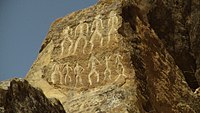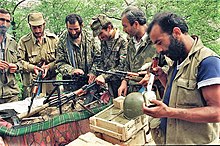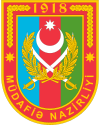
Azerbaijan, officially the Republic of Azerbaijan, is a transcontinental country located at the boundary of Eastern Europe and West Asia. It is a part of the South Caucasus region and is bounded by the Caspian Sea to the east, Russia to the north, Georgia to the northwest, Armenia and Turkey to the west, and Iran to the south. Baku is the capital and largest city.
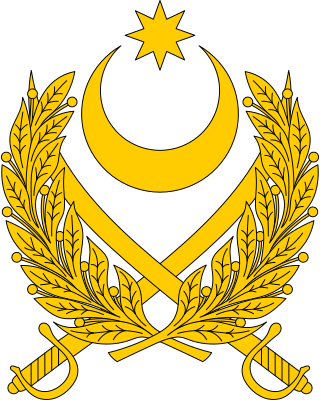
The Azerbaijani Armed Forces is the military of the Republic of Azerbaijan. It was re-established according to the country's Law of the Armed Forces on 9 October 1991. The original Azerbaijan Democratic Republic's armed forces were dissolved after Azerbaijan was absorbed into the Soviet Union as the Azerbaijan Soviet Socialist Republic from 28 April 1920. After the Soviet Union dissolved in 1991–92, Azerbaijan's armed forces were reformed based on Soviet bases and equipment left on Azerbaijani soil.

Nagorno-Karabakh is a region in Azerbaijan, covering the southeastern stretch of the Lesser Caucasus mountain range. Part of the greater region of Karabakh, it spans the area between Lower Karabakh and Syunik. Its terrain mostly consists of mountains and forestland.
Articles related to the Azerbaijan Republic include:

The Azerbaijan Democratic Republic, also known as the Azerbaijan People's Republic, was the first secular democratic republic in the Turkic and Muslim worlds. The ADR was founded by the Azerbaijani National Council in Tiflis on 28 May 1918 after the collapse of the Transcaucasian Democratic Federative Republic, and ceased to exist on April 28, 1920. Its established borders were with Russia to the north, the Democratic Republic of Georgia to the north-west, the Republic of Armenia to the west, and Iran to the south. It had a population of around 3 million. Ganja was the temporary capital of the Republic as Baku was under Bolshevik control. The name of "Azerbaijan" which the leading Musavat party adopted, for political reasons, was, prior to the establishment of the Azerbaijan Democratic Republic in 1918, exclusively used to identify the adjacent region of contemporary northwestern Iran.

The Islamic Army of the Caucasus was a military unit of the Ottoman Empire formed on July 10, 1918. The Ottoman Minister of War, Enver Pasha, ordered its establishment, and it played a major role during the Caucasus Campaign of World War I.

The First Nagorno-Karabakh War was an ethnic and territorial conflict that took place from February 1988 to May 1994, in the enclave of Nagorno-Karabakh in southwestern Azerbaijan, between the majority ethnic Armenians of Nagorno-Karabakh backed by Armenia, and the Republic of Azerbaijan with support from Turkey. As the war progressed, Armenia and Azerbaijan, both former Soviet republics, entangled themselves in protracted, undeclared mountain warfare in the mountainous heights of Karabakh as Azerbaijan attempted to curb the secessionist movement in Nagorno-Karabakh.

The history of Azerbaijan is understood as the history of the region now forming the Republic of Azerbaijan. Topographically, the land is contained by the southern slopes of the Caucasus Mountains in the north, the Caspian Sea in the east, and the Armenian Highlands in the west. In the south, its natural boundaries are less distinct, and here the country merges with the Iranian Plateau.

The Nagorno-Karabakh conflict was an ethnic and territorial conflict between Armenia and Azerbaijan over the region of Nagorno-Karabakh, inhabited mostly by ethnic Armenians until 2023, and seven surrounding districts, inhabited mostly by Azerbaijanis until their expulsion during the 1990s. The Nagorno-Karabakh region has been entirely claimed by and partially controlled by the breakaway Republic of Artsakh, but was recognized internationally as part of Azerbaijan. Azerbaijan gradually re-established control over Nagorno-Karabakh region and the seven surrounding districts.

The Azerbaijani Land Forces are the land force component of the Azerbaijani Armed Forces. Since the fall of the Soviet Union, Azerbaijan has been trying to create professional, well trained, and mobile armed forces. Based on 2013 statistics, the country has about 56,850 ground force troops, with additional paramilitary forces of 15,000. In addition, there are 300,000 former service personnel who have had military service in the last fifteen years.
Nagorno-Karabakh is located in the southern part of the Lesser Caucasus range, at the eastern edge of the Armenian Highlands, encompassing the highland part of the wider geographical region known as Karabakh. Under Russian and Soviet rule, the region came to be known as Nagorno-Karabakh, meaning "Mountainous Karabakh" in Russian. The name Karabakh itself was first encountered in Georgian and Persian sources from the 13th and 14th centuries to refer to lowlands between the Kura and Aras rivers and the adjacent mountainous territory.
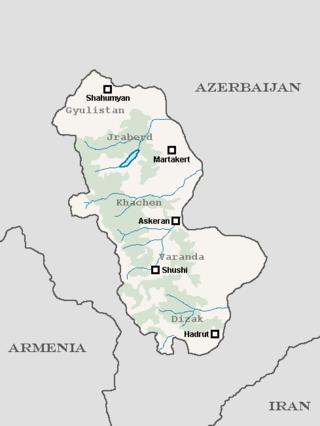
The Karabakh Council was the unrecognised government over Mountainous Karabakh (Nagorno-Karabakh) in eastern Armenia between 1918 and 1920. The council's body was elected by the assembly of Mountainous Karabakh—the representative body of the people of Nagorno-Karabakh—on 27 July 1918. Initially it was called the People's Government of Karabakh, but in September 1918 it was renamed into the Karabakh Council. The Karabakh Council's control throughout 1918–1920 did not exceed the ethnic Armenian locales of Karabakh which were subordinate to them. The council's statehood related to the historical Artsakh province and the modern-day self-proclaimed Republic of Artsakh founded in 1991. Its capital was the city of Shushi (Shusha).

The Armenian-Azerbaijani war (1918–1920) was a conflict that took place in the South Caucasus in regions with a mixed Armenian-Azerbaijani population, broadly encompassing what are now modern-day Azerbaijan and Armenia. It began during the final months of World War I and ended with the establishment of Soviet rule.

Azerbaijani nationalism, also referred to as Azerbaijanism, started out as a cultural movement among Azerbaijani intellectuals within the Russian Empire during the second half of the 19th century. While initially cultural in nature, it was later developed further into a political ideology which culminated in the establishment of the Azerbaijan Democratic Republic in 1918.
Armenians in Azerbaijan are the Armenians who lived in great numbers in the modern state of Azerbaijan and its precursor, Soviet Azerbaijan. According to the statistics, about 500,000 Armenians lived in Soviet Azerbaijan prior to the outbreak of the First Nagorno-Karabakh War in 1988. Most of the Armenian-Azerbaijanis however had to flee the republic, like Azerbaijanis in Armenia, in the events leading up to the First Nagorno-Karabakh War, a result of the ongoing Armenian-Azerbaijani conflict. Atrocities directed against the Armenian population took place in Sumgait, Ganja and Baku. Today the vast majority of Armenians in Azerbaijan live in territory controlled by the break-away region Nagorno-Karabakh which declared its unilateral act of independence in 1991 under the name Nagorno-Karabakh Republic but has not been recognised by any country, including Armenia.

The history of the Caucasus region may be divided by geography into the history of the North Caucasus (Ciscaucasia), historically in the sphere of influence of Scythia and of Southern Russia, and that of the South Caucasus in the sphere of influence of Persia, Anatolia, and Assyria.
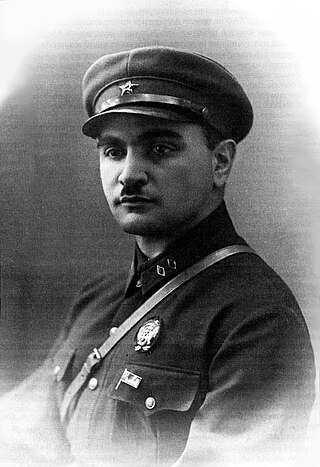
Jamshid Jafargulu oglu Nakhchivanski, also known as Jamshid Khan Nakhichevanski, was a Russian Imperial, Azerbaijani and Soviet military commander. He rose to the rank of Combrig in the Soviet Army.
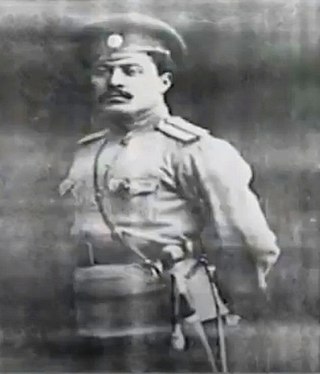
Tarlan Abdullah oglu Aliyarbayov, also known as Tarlan bey Abdullah bey oglu Aliyarbeyov, nicknamed the Tarlan of Shamakhi, was a Soviet military officer who served as a major general in the Red Army, a military educator and a politician of Azerbaijani origin. He previously served in the Imperial Russian and Azerbaijani armies, and served in World War I, for which he was awarded the Order of Saint Stanislaus and the Order of Saint Anna, as well as the Russian Civil War and the Armenian–Azerbaijani War. Aliyarbayov was one of three Azerbaijanis who fought in both World Wars and the Russian Civil War; the others were Ali-Agha Shikhlinski and Samad bey Mehmandarov.

The Zangezur uezd was a county (uezd) of the Elizavetpol Governorate of the Russian Empire with its administrative center in Gerusy from 1868 until its formal abolition and partition between the Soviet republics of Armenia and Azerbaijan in 1921. The area of the Zangezur uezd corresponded to most of the contemporary Syunik province of Armenia, and Lachin, Gubadly, Zangilan, and Shusha districts of Azerbaijan.
